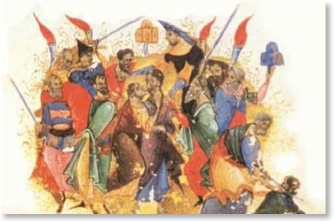ARMENIAN GRAMMATICAL
DEVELOPMENT

Unlike many modern languages with roots in ancient times and contrary to the assertions that the language has gone through radical changes through the ages, only few of the grammatical fundamentals have been modified since the first surviving texts while the basic vocabulary remained remarkably intact except the addition of new loan words or coining of new derivatives or compound words. As a matter of fact, an average knowledge of Modern (Western or Eastern) Armenian is adequate to read and fully understand the Armenian Bible, written in Classical Armenian (circa 425 BC).
Since early in the 5th century, Armenian grammarians developed the new fundamentals that contributed to the evolution and advancement of Armenian grammatical and linguistic principles.
The word grammar was once a synonym for learning in general. In early English usage, grammar meant only Latin grammar. Not until the 17th century was the word used generically. In the early Armenian centers of higher learning (5th century and onwards), Grammatical Structures as well as Rhetoric and Lexicology were considered part of the Armenian linguistic tradition and heritage.

Movses Kertoghahayr (5th-6th centuries) researched the phonetic features of the Armenian language by elucidating the differing aspects of the sounds and the letters they designate. Stepanos Sunetsi (735) is known for his research on pronunciation and etymology as well as his writings on the principles and rules of the exact articulation of separate sounds and syllables. He was also the first Armenian linguist known for his classification of the vowels and diphthongs. Krikor Magistros Pahlavouni’s (990-1059) Definition of Grammar is another monumental work on the subject of Armenian grammar and syntax. Long before F. Bopp had established the discipline of comparative languages in early 19th century, K. Pahlavouni had written many comparative studies on Armenian and Arabic languages.
In addition to pursuing the development of the classical grammatical elements of the language, linguists in the Armenian kingdom of Cilicia pioneered a new branch by developing the “art of writing.” During this period, the first orthographic reform was carried out. Aristages Kritch (12th century) introduced a methodology and certain orthographic principles that served as the basis for future linguists. Remarkably, two grammatical works by Vartan Areveltsi (1269) are written in Middle Armenian, the precursor of Modern Armenian. His Parts of Speech is the first attempt to elaborate the principles of Armenian syntax. Interestingly, Areveltsi predicted that in the future all mankind will use one general language. Another grammarian of this era, Hovhannes Yerzingatsi, the author of A Collection of Definition of Grammar, defies Plato’s contention that “…a power more than human gave things their first names” and considers language as an achievement of human intellect and not guided by divine intervention.
Among the grammarians of 14th and 15th centuries, Essai Nshetsi, Krikor Datevatsi, Hagop Khrimetsi and Arakel Sunetsi have made more than a casual contribution to the fundamentals of Armenian grammar.
It is perhaps worthy to note that Armenian grammarians, throughout the centuries, were in their own right also creative writers, translators or experts on foreign languages.
The
Words of Poetry,
known in the 13th
century, defining “difficult” words in poetry
and other grammatical works, as well as
dialectal words, can be considered one of the
first dictionaries in the Armenian language.

Essence is expressed by grammar.
Ludwig
Wittgenstein